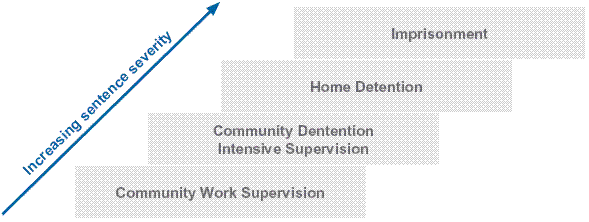Outcome: Compliance with Sentences and Orders is Ensured
What the Department is seeking to achieve
Ensuring sentence and order compliance is the Department’s core business – it is critical to the integrity of sentences and orders.
Effective compliance with sentences and orders is when offenders:
- complete their sentences
- comply with the restrictions of their sentences
- are positively motivated to comply with their sentences
- experience appropriate consequences when they do not comply
- are treated fairly
- in the case of prisons, are incarcerated in a safe, secure and humane environment.
By achieving the above, the Department contributes directly to improving public safety. Holding offenders to account for crimes maintains public trust and confidence in the justice system.
What the Department will do to achieve this outcome
The Department of Corrections is responsible for ensuring that offenders comply with the restrictions of their sentences. This covers a large range of sentences, as illustrated in the following diagram.
When dealing with offenders in the community and in prisons, Corrections’ staff have a key role motivating offenders to comply with sentences. Staff motivate offenders by treating them fairly with dignity and humanity, meeting offenders’ legitimate needs, providing rehabilitative services, and managing offenders safely and humanely.
When community-based offenders breach conditions of their sentence, enforcement action is taken, such as prosecution for the breach, and recalls to prison for breaches of parole conditions.
Within prisons, the Department’s staff are responsible for managing prisoners so that they comply with appropriate restrictions. Physical security is constantly reviewed, maintained and improved. This includes constructing perimeter fences, installing detection and other surveillance systems, and introducing single points-of-entry into prisons. The Department works to prevent prisoners committing or initiating offences from within prison, such as violence, drug use, or smuggling contraband (including drugs and cell phones).
The Department is building an intelligence capability known as Crime Prevention Information Capability (CPIC). CPIC is based on best-practice models of intelligence seen in justice sector agencies such as NZ Police and NZ Customs Service, as well as overseas corrections jurisdictions including Australia, Canada and the United Kingdom.
CPIC analyses information to assist in the decision making process relating to the prevention and management of incidents. It is used to develop strategies to mitigate risk to security objectives and promote the prevention and detection of crime.
In ensuring sentence and order compliance, an important restriction is curbing prisoners’ access to drugs and alcohol. The Strategy to Reduce Alcohol and Drug Use by Offenders outlines the work the Department does in this area. It can be viewed at www.corrections.govt.nz/public/pdf/strategy-reduce-drug-and-alcohol/doc-strategy-to-reduce.pdf
As with all outcomes, the Department works with other agencies to ensure offenders comply with sentences. In particular, the Department works closely with:
- the New Zealand Police to share information and cooperate on the management of sentences and orders served in the community. The Department and the New Zealand Police take a coordinated approach to deterring crime in prisons
- the Ministry of Justice by exchanging sentencing-related information, provision of notifications of hearings, the delivery of bail documentation and organising Visiting Justice Services to prisons
- the New Zealand Immigration Service branch of the Department of Labour in ensuring compliance with revocation and deportation orders.
Ensuring sentence and order compliance is a priority outcome in the 2008–13 Strategic Business Plan. Over the next five years the Department will:
- do the basics right and retain high levels of professional standards
- review core systems and processes to ensure consistency, coherency, and where possible, simplicity
- improve understanding of the core systems and processes through focused training and induction processes
- monitor levels of compliance and provide feedback to staff
- improve the timeliness and appropriateness of response to offender non-compliance
- strengthen communication between staff managing different sentences, especially in light of the increase in multiple sentences for individual offenders
- strengthen the focus on quality and business improvements.
Specific projects that the Department will work on over the medium term to ensure sentence and order compliance include:
- implementing crime prevention activities in prison, such as designing, developing and delivering appropriate systems to manage the unauthorised use of cell phones in prisons and appropriate systems and staff to monitor prisoners’ telephone calls
- building Crime Prevention Information Capability (CPIC)
- developing a new Strategy to Reduce Alcohol and Drug Use to cover the period 2008–13
- supporting the passage of the Corrections Amendment Bill (No.2) which contains a number of measures that improve the Department’s ability to control drugs, cell phones and other contraband.
The Department delivers services on a day-to-day basis grouped as output classes that contribute to its outcomes. Output classes that contribute to ensuring compliance with sentences and orders include:
- Output Class 2: Community-based Sentences and Orders.
- Output Class 3: Custody of Remand Prisoners.
- Output Class 4: Escorts and Custodial Supervision.
- Output Class 5: Custodial Services.
- Output Class 8: Services to the New Zealand Parole Board.
How the Department will demonstrate success in achieving this outcome
The Department will use the following outcome indicators to monitor its contribution to ensuring sentence and order compliance. It will monitor:
- sentence compliance and completion rates
- escapes from prison
- drug use amongst prisoners.


